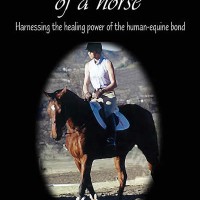While horses can teach us many things, perhaps the most important thing we can understand is how to take another’s perspective. Never is this more important than with autistic children.
Autism came more into public recently with the release of the well-received “The Horse Boy: A Father’s Quest to Heal His Son” by Rupert Isaacson. The book was then made into a movie, and Isaacson created a foundation to promulgate his methods when working with autistic children.
The website for Isaacson’s foundation discusses many aspects of both autism and classical dressage riding, beautifully infusing the two to create a template for understanding not only the reality of autism, but life through fundamental dressage principles.
For example, Isaacson discusses how rhythm, the second element of the German dressage training scale, assists in the production of oxytocin, a critical element of bonding. Interestingly, Isaacson also found that there was an interesting link between his autistic son’s communication skills and the development of collection in the horse.
In addressing the critical concept of perspective taking, here is what Isaacson has to say:
“Perhaps the most important survival skill a human being can learn is how to take another person’s perspective. So what does that mean exactly? It means knowing when someone is lying or telling the truth. It means learning to recognize and react to moods. It means knowing that other people think differently to you and adjusting your behavior accordingly.
In neuro-typical kids perspective taking manifests itself first with pointing. Obviously this is something once can model a lot while back-riding and the child can pick this up gradually by osmosis as you spend more and more time together is the saddle – you pointing out objects continually and commenting on them and the child responding, especially when you point out objects that you know the child will have an interest in.
However, it gets more interesting than this: for the horse can help the child through their first perspective-taking steps – by literally carrying the child in and out of another person’s perspective. We do this with one rider and child on one side of a barrier (which can be made up of people all standing in a line) and another rider and child on the other side. You place a bucket on one side of the human barrier and a saddle on the other. Let’s say you start on the side facing the saddle. You say, “Hey look – we see a saddle. I wonder if the other people see what we see – let’s go find out.” Then you ride around the other side: “How about that! They didn’t see a saddle like we did! They see a bucket! Does that mean they now see what we see? Let’s go find out…”
The most important thing here is NOT TO ASK FOR AN ANSWER FROM THE CHILD – because they won’t know the answer and you are setting them up for failure if you do that. So just keep the dialogue going: “Do they see what we see? I don’t know, let’s go find out. Hey – how about that! They see a saddle! Etc.”
Why do this? Because this builds what psychologists call ‘Theory of Mind”: the ability to know that someone else thinks differently sees differently to you. Young autistic kids have a notoriously hard time with this. Some never get it. The horse can show them effortlessly, allowing them to get the concept by slow drip osmosis, carrying them in and out of another person’s perspective.
From these simple exercises we go on to rule based games like ‘Tag – You’re It!” and ‘Hide and Seek!” These rule based games are the next milestones in perspective taking and theory of mind. We go into how to teach them without pressure and without possibility of failure in our training video. The horse’s ability to carry the kid through the process means that the child never has to worry about getting it wrong, can learn at their own pace, and can experience the fun of chasing around at the canter as part of it all – which in turns breeds communication because of the euphoria induced by the sensation of being on a cantering horse.”
A pioneer in the field of autism, Isaacson’s book, endorsed by none other than Temple Grandin, an autistic herself and another pioneer, gives a much more comprehensive view of his approach to autism.
For more information about Isaacson and his work, visit www.horseboyfoundation.org.
Best,
Claire Dorotik LMFT
